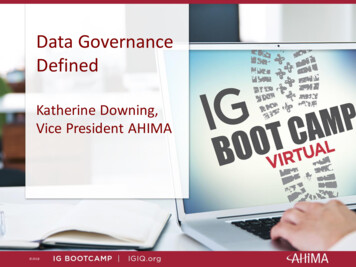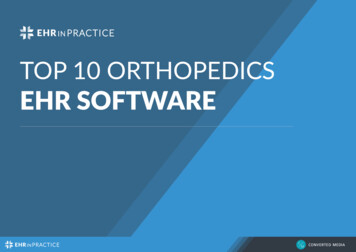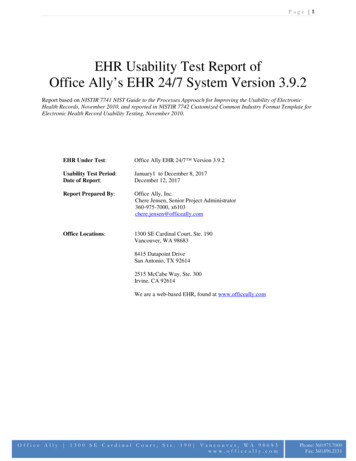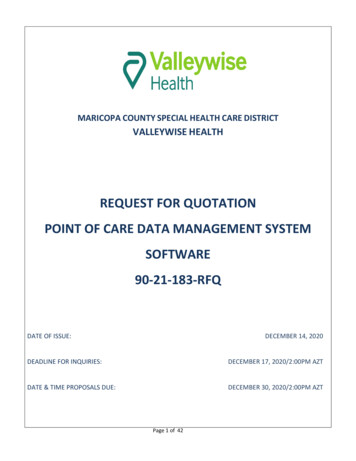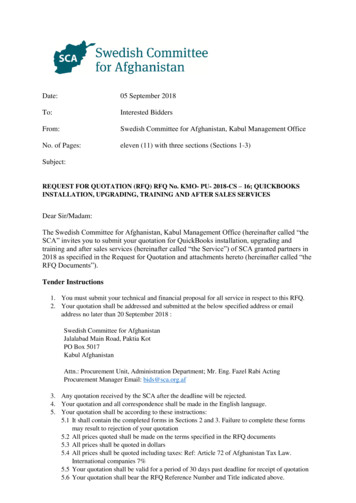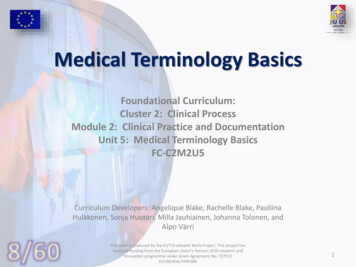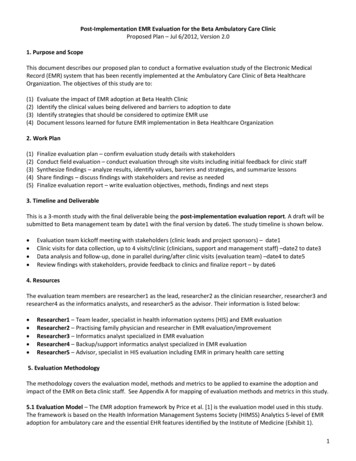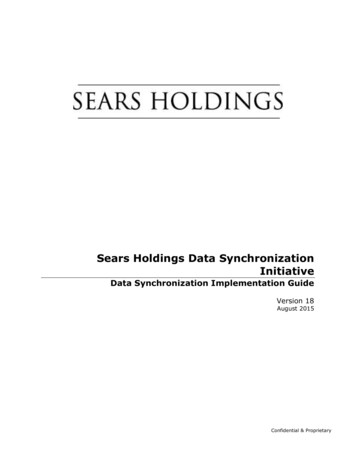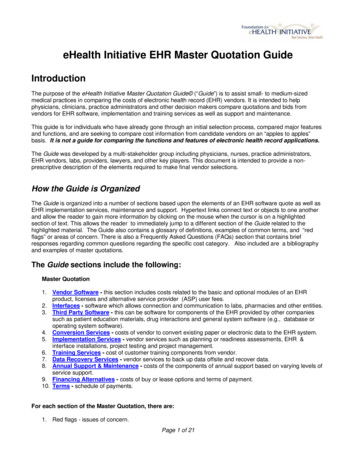
Transcription
eHealth Initiative EHR Master Quotation GuideIntroductionThe purpose of the eHealth Initiative Master Quotation Guide (“Guide”) is to assist small- to medium-sizedmedical practices in comparing the costs of electronic health record (EHR) vendors. It is intended to helpphysicians, clinicians, practice administrators and other decision makers compare quotations and bids fromvendors for EHR software, implementation and training services as well as support and maintenance.This guide is for individuals who have already gone through an initial selection process, compared major featuresand functions, and are seeking to compare cost information from candidate vendors on an “apples to apples”basis. It is not a guide for comparing the functions and features of electronic health record applications.The Guide was developed by a multi-stakeholder group including physicians, nurses, practice administrators,EHR vendors, labs, providers, lawyers, and other key players. This document is intended to provide a nonprescriptive description of the elements required to make final vendor selections.How the Guide is OrganizedThe Guide is organized into a number of sections based upon the elements of an EHR software quote as well asEHR implementation services, maintenance and support. Hypertext links connect text or objects to one anotherand allow the reader to gain more information by clicking on the mouse when the cursor is on a highlightedsection of text. This allows the reader to immediately jump to a different section of the Guide related to thehighlighted material. The Guide also contains a glossary of definitions, examples of common terms, and “redflags” or areas of concern. There is also a Frequently Asked Questions (FAQs) section that contains briefresponses regarding common questions regarding the specific cost category. Also included are a bibliographyand examples of master quotations.The Guide sections include the following:Master Quotation1. Vendor Software - this section includes costs related to the basic and optional modules of an EHRproduct, licenses and alternative service provider (ASP) user fees.2. Interfaces - software which allows connection and communication to labs, pharmacies and other entities.3. Third Party Software - this can be software for components of the EHR provided by other companiessuch as patient education materials, drug interactions and general system software (e.g., database oroperating system software).4. Conversion Services - costs of vendor to convert existing paper or electronic data to the EHR system.5. Implementation Services - vendor services such as planning or readiness assessments, EHR &interface installations, project testing and project management.6. Training Services - cost of customer training components from vendor.7. Data Recovery Services - vendor services to back up data offsite and recover data.8. Annual Support & Maintenance - costs of the components of annual support based on varying levels ofservice support.9. Financing Alternatives - costs of buy or lease options and terms of payment.10. Terms - schedule of payments.For each section of the Master Quotation, there are:1. Red flags - issues of concern.Page 1 of 21
2. Frequently Asked Questions (FAQ’s) - common questions and answers related to the master quotation.3. Glossary of terms.Service Level AgreementStructure and component options within a standard service level agreement.*Note: This guide will be updated as questions arise and health information technology evolves.We hope that you will find the Guide useful and encourage your questions and comments.Vendor NameProduct of InterestVendor Representative Completing FormVendor Representative Telephone NumberRequest for Quote Submitted by:Physician Practice NamePractice Contact PersonPractice AddressPractice TelephonePractice Demographics:This space needs to include the basic information a vendor would need to provide a quote – e.g., numbers andFTEs of clinician providers (physicians, NPs, PAs) as well as staff.Page 2 of 21
Vendor Software LicensesThe tables below are provided for the vendor to quote fees for licensing the basic and optional modules, includingthe basis upon which those fees are determined. If there are qualifications to this quote, the vendor should enterthe information into the corresponding comment field.Basic modulesAnnual fee calculated per:Concurrent (Seat)Per provider (Named User)ASPLicense Fee(1 one time cost,2 Yearly renewal)# Licenses“Provider”IncludesCommentsOptional ModulesLicense FeeCommentsLicense OtherSpecialty ModulesList all availableInterfacesPhysician: Please mark “X” in Box A to indicate a desired interface and identify in Box B the product to which theinterface should be written.Vendor: Please enter quote for interface development in Box C and indicate by entering “yes” in Box D if youhave successfully interfaced the with physician’s identified system in the last 12 months If you wish to offercomment, please reference by number or symbol in Box E and offer the corresponding comment in the spacebelow or on a separate sheet.Page 3 of 21
Interfaces Requested:CommunicationsIfInterfaceis desired,mark ”X”Desired Interface to:(vendor of service ofsoftware and softwareversion, if known – i.e.,Quest/Labcorp, nameand release of practicemanagement system)UNI – Data travels onewayBI – Data travels bothwaysLabOrder entryResults reportingProvider owned LabHospital Lab(s)Commercial Lab(s)PharmacySureScripts Certified (unior bidirectional)Rx eligibility (providedby?)Formulary information(Plan level or memberlevel?)RX reference database(includes checking fordrug-drug interaction,drug-allergy reaction,other?)PBM Connectivity (whichones?)RadiologyOrder entryResults reportingReportsImagesHospitalHospital H&P reportsDischarge SummariesOtherReportingPayersQuality Assurance Org.CMSMedicaidOther PayorSecure ProviderMessagingSecure Patient MessagingPay-for-performancereportingPage 4 of 21Vendor cost(include yourcost andestimate for labcost, and annualsupportProduction Interface inlast 12months“YES”Comment(Vendor -Insertcomment numberand add commentbelow table)
Interfaces Requested:Patient CareIfInterfaceis desired,mark ”X”Desired Interface to:(vendor of service ofsoftware and softwareversion, if known – i.e.,Quest/Labcorp, nameand release of practicemanagement system)UNI – Data travels onewayBI – Data travels bothwaysVendor cost(include yourcost andestimate for labcost, and annualsupportProduction Interface inlast 12months“YES”Comment(Vendor -Insertcomment numberand add commentbelow table)Instrument DataEGG/Holter/SpirometryOther Diag. EquipmentPractice Mgmt.Transcription SystemsVoice RecognitionAppt. Reminder/IVRElectronic ClaimsPractice Mgmt SystemBillingSchedulingQuality MeasurementCustom InterfacesOther (Specify)To physician: vendor will require additional information to evaluate reporting interfaces. Please attach name ofentity to which you wish to interface and the contact person for that entity.Comments (notes from Box E): Include basis for estimate, including whether fee is fixed fee or hourly rate. Ifhourly rate, provide estimate of hours required.Page 5 of 21
Third Party SoftwareEHR SpecificVendor: In the spaces below, indicate whether these functions are included in the above quote. If not, identify ifthey are available and the additional fees to access those functions.OptionIncluded in BasePrice Above(Yes/No)Available forAdditional Fee(Yes/No)Annual Cost(In addition to the Quotefrom Table X)CommentReferencePatient EducationDrug InteractionDrug/allergyDrug/diagnosisICD9 data baseCPT4 data baseSNOMED orSNOMED CTHCPCS databaseVoice recognitionInsurance plan and/orPBM formulariesBest Practices /National GuidelinesComment: Note in the space below any clarifications related to the identified option, the product’s ability to support it and anyadditional fees that will apply.General SystemOptionIncluded in BasePrice Above(Yes/No)Available forAdditional Fee(Yes/No)Annual Cost(In addition to the Quotefrom Table X)CommentReferenceDatabaseOperating SystemReport WritersOther Tolls (specify)Comment: Note in the space below any clarifications related to the identified option, the product’s ability to support it and anyadditional fees that will apply.Page 6 of 21
Page 7 of 21
Conversion ServicesOptionCost of OptionHourly or Fixed FeeComment ReferenceData Migration OptionsStructured/Non-structuredPaper FormatElectronic FormatComment: Note in the space below any clarifications related to the identified optionImplementation ServicesOptionCost of OptionHourly or Fixed FeePre-implementation planningReadiness assessmentRequirementsEHR InstallationInterface InstallationTemplate customizationTestingProject ManagementComment: Note in the space below any clarifications related to the identified optionPage 8 of 21Comment Reference
Training ServicesOptionCost of OptionHourly or DailyComment ReferenceBasic computer trainingOnsite/remoteExpensesStaff retraining for updatesOther training (specifyComment: Note in the space below any clarifications related to the identified optionData Recovery ServicesOptionCost of OptionHourly or MonthlyOff site storage of dataRecreation of databaseComment: Note in the space below any clarifications related to the identified optionPage 9 of 21Comment Reference
Annual Support & MaintenanceOptionFeesComment ReferenceGeneralUpgrades/EnhancementsSource Code escrowData schemaService Level AgreementsLevel 1Level 2Level 3Interfaces3rd party Pass throughVendor Service LevelThird Party – EHR SpecificDatabase updatesApplication updatesThird Party – General System3rd party Pass throughComment: Note in the space below any clarifications related to the identified option.Financing AlternativesFinance (finance company)Lease (leasing company)TermsTERMSPayment terms should be spread out over the course of the project and implementation. There are three basicareas to be considered with upfront payment, payments during implementation and final payment upon thecompletion of the project.Page 10 of 21
Service Level Agreement(Support and Maintenance proposed template)Hours of supportM-F24/7WeekendsHolidaysMethods of supportEmailPhoneremote accessin-personSeverity/Priority ClassificationLevel 1EHR DownLevel 2Lab Interface DownLevel 3Patient Education DB DownLevel 4Customizations and/or desired new featuresResponse TimesDependant on severity and service levelProblem Escalation & TriageDependant on severity and service levelRules and mechanisms to elevate unresolved problems to next levelMechanism for diagnosis/resolution of hardware vs. software problemsCustomer Responsibilities & DutiesDocument steps to problemAttempt to recreate problemRecord all error messagesReport within 24hrs.Page 11 of 21
Service Level Agreement Compliance ReportingStatistics on meeting Service Level Agreement commitmentsPage 12 of 21
Glossary, Red Flags, and Frequently Asked Questions (FAQ’s)Vendor Software LicensesLicense cost of various modules. Typically, modules will be licensed on a concurrent or named user basis.For example, with a concurrent license, if there are 4 providers and 8 employees, a minimum of 12 concurrentlicenses would be needed. However, if the providers were halftime [meaning, they only used the system halftime] (and all 4 never used the system at any one time, only 10 licenses would be needed).If using aa named user license under the same circumstances, 12 licenses would always be needed – aslicenses are not shared among different people. There can be a provision though for “active” and “inactive”providers (which means they could look at information, but not enter it in the system).Under an ASP (monthly rental agreement), software licenses are not being purchased, but rented However, thesame issues exist for determining number of ASP licenses as with a license purchase.Red Flags or Things to Look Out For1. Vendor doesn’t specify type of license in quote2. Functionality is not specified.3. Not specified for what period of time license is in forceFAQ’sWhat is the best type of license?Perpetual concurrentWhat is the definition of provider for the license?Depends on quote – can be physician, NP, PA or othersWhat is the difference between perpetual and term license?Perpetual is a one-time license fee. Term is a renewable license fee Back to Top InterfacesSoftware programs that allow data from the EHR System to flow back and forth between external applications.These applications can either reside outside the practice, such as lab applications or can be another systemwithin the practice, such as a billing system.Red Flags or Things to Look Out For1.2.3.4.One-way or two-way interface is not specifiedData format not specified (structured or non-structured)Additional license costs, if any, not specifiedInterface promised, but not availableFAQ’sDoes cost cover third party updates?Page 13 of 21
Typically you would pay for third party updates, but depends on the vendorDoes every interface need some customization?Not necessarily, but make sure the vendor demonstrates the functionalityWhat if the vendor says they will have the interface soon?Ask for a development plan and timeline to verify claims Back to Top Third Party: EHR SpecificThese are applications that are essential to the basic infrastructure of the system. They are the building blocks,such as the technical platform upon which the EHR system is built (e.g.,Windows, Linux, or MacIntosh, etc.) Alsowhat kind of database structure controls the system (e.g, SQL, Oracle, etc.).When comparing license costs, note if there are separate general system license costs or if these are rolled intothe main cost. Also, ask whether there will be additional costs when the vendor upgrades their software and itbecomes necessary to install a new version of the database or operating system. Make sure your infrastructuresoftware will support any features you wish to add later on.Red Flags or Things to Look Out For1. Extra cost is not specified in quote2. Customer is responsible for learning about updates3. The database is proprietary; not standardFAQ’sHow often should a third party database be updated?Depends on the content. e.g. Drug interactions should have more frequency than patient educationShould updates cost extra?Should be part of support and maintenance Back to Top Third Party: General SystemThese are applications that are essential to the basic infrastructure of the system. They are the building blockssuch as the technical platform the EHR system is built on such as, Windows, Linux, or MacIntosh, etc. Also whatkind of database structure controls the system – SQL, Oracle, etc.When comparing license costs note if there are separate general system license costs or if these are rolled intothe main cost. Also, will there be additional costs when the vendor upgrades their software and it is necessary toinstall a new version of the database or operating system. Make sure your infrastructure software will support anyfeatures you wish to add later on.Red Flags or Things to Look Out For1. Extra cost is not specified in quote2. Customer is responsible to be aware of updates3. The database is not standard, but proprietaryPage 14 of 21
FAQ’sWhat is the best technology to use as a platform?There are various operating systems and databases. However, make sure that the technology is not proprietaryShould you always update to the latest database and operating system?Not necessarily right away, find out if this will impact your EHR systemWho should be responsible for updating the general system software?Typically the customer is responsible for installing general system updates Back to Top Conversion ServicesThese are consulting services offered by the vendor. These services will take your original data, either in paper orelectronic form, and transfer the data into the EHR system database.Red Flags or Things to Look Out For1. No time estimates given2. Costs don’t include any guaranteesFAQ’sHow long does a conversion typically take?Depends on complexity. Make sure that a detailed plan is presented with timelinesHow do I know everything was converted correctly?Develop a robust test plan with the vendorIs there a chance that my information can’t be converted?If it is in electronic format, as long as you have the underlying database structure, there shouldn’t be a problem Back To Top Implementation ServicesThese are consulting services offered by the vendor. These services will provide planning and actualimplementation of an EHR system.It is important when comparing quoted implementation costs that physicians understand which detailed cost lineitems a particular vendor will be supplying. Also, make sure and take a look at their project plans.Red Flags or Things to Look Out For1. Vendor can’t commit to a project plan with milestones2. Only vendor can customize templates3. Implementation is not broken into small enough tasksPage 15 of 21
FAQ’sDo I need to be involved?Absolutely. Designate a point person who is responsible to interface with the vendor on a regular basisHow do I know the vendor is completing all the tasks?Review the vendor’s detailed project plan and have regular status meetingsWhy do implementations fail?Not enough involvement, communication, and regular status reviewWho should be involved in a needs assessment?Both the vendor and members of your staff who will use the system Back to Top Training ServicesThese are consulting services offered by the vendor. They provide hands on training for all aspects of the system.Red Flags or Things to Look Out For1. There is no cost listed for future training2. There is no formal training plan3. There is no definition of what expenses will be reimbursed along with limitsFAQ’sIs it better to ask the vendor to train the whole staff or “train the trainer”?Depends on the size of the staffHow do I know if my staff has been trained adequately?You should develop real life scenarios and test themHow much time will training take?It depends on many factors, but make sure the vendor gives you a training plan outlining this Back to Top Data Recovery ServicesA mechanism and process to safely store duplicate databases and recreate the data should a disaster occur.Red Flags or Things to Look Out For1. Back ups not made on regular schedule2. Off site storage not as secure as it should be3. No process documented for recoveryFAQ’sWhat do you look for in off site storage?Page 16 of 21
Scrutinize the security and environment of the location in which the backups are being held. Ask about theregularity of the backup process. Find out about accessibility to your data.Should I just backup on my own?As long as you have a safe and secure location to store backups and you will backup regularly Back to Top Annual Support & MaintenanceSupport and maintenance costs are typically 15-20 % of the software license costs. Where the actual license isnormally a one- time fee, the support and maintenance costs are renewed on a yearly basis. This yearly feebasically covers two areas: 1) any upgrades or new releases; and 2) customer service and support.It should be noted that both vendor EHR software and third party software will need support, so it is important todetermine which components the support costs cover.Also, some vendors might have more than one service level agreement representing different support options atdifferent costs.Red Flags or Things to Look Out For1.2.3.4.5.6.7.8.9.No support agreementNo guarantees of serviceNo cap on renewal percentage increasesNo software escrow costs offeredExtra costs for database schemaAdded maintenance costs for third party productsNo support for third party productsNo support for previous version or releaseCut off of support services if payment is in disputeFAQ’sWhat type of guarantees of service should I expect?Depending on your service agreement there should be guaranteed respon
medical practices in comparing the costs of electronic health record (EHR) vendors. It is intended to help physicians, clinicians, practice administrators and other decision makers compare quotations and bids from vendors for EHR software, implementation and
